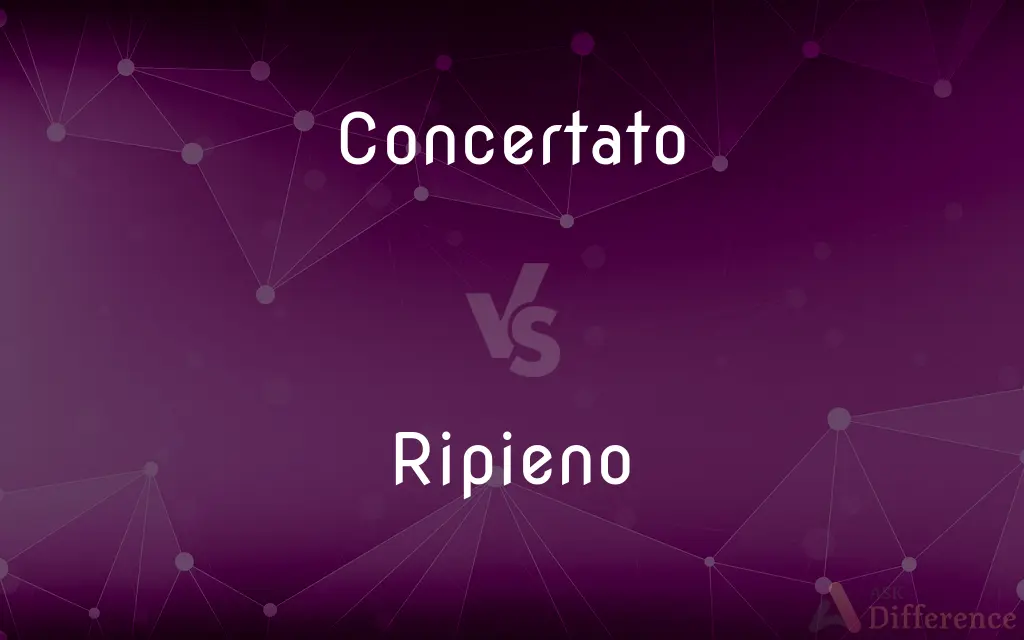Concertato vs. Ripieno — What's the Difference?
Edited by Tayyaba Rehman — By Maham Liaqat — Updated on May 6, 2024
Concertato style features contrasting voices or instruments, highlighting individual parts; whereas, ripieno refers to the full ensemble used in Baroque concertos, providing a homogenous sound.

Difference Between Concertato and Ripieno
Table of Contents
ADVERTISEMENT
Key Differences
Concertato style emphasizes the contrast between different musical voices or sections, often utilizing soloists against a larger ensemble. This creates a dynamic interplay that's integral to Baroque and Renaissance music. On the other hand, ripieno involves the full ensemble, playing together to produce a uniform texture and sound, commonly seen in the tutti sections of a concerto.
Concertato often showcases specific talents of individual performers, allowing for expressive solo sections where each voice or instrument can stand out. Whereas, ripieno serves as the backdrop or the full ensemble sound, supporting the solos or leading the harmonic foundation in a piece.
In the context of a concerto grosso, a popular form in the Baroque era, concertato sections are characterized by intricate and expressive solos or small groups called concertino. Conversely, ripieno sections involve the larger group or orchestra, which complements and contrasts the concertino.
While concertato sections are typically more varied and elaborate, featuring virtuosic displays and interactive dialogues between soloists and ensemble, ripieno maintains a consistent and often repetitive background, emphasizing stability and continuity in the composition.
Concertato can often involve improvisation or ornamentation by the soloists, providing a unique and personal touch to each performance. In contrast, ripieno parts are usually strictly notated, with less room for individual variation, focusing on creating a powerful collective sound.
ADVERTISEMENT
Comparison Chart
Definition
Style emphasizing contrast between soloists and ensemble
Full ensemble sound in a concerto
Usage in music
Highlights individual parts for expressive effect
Provides uniform texture and supports solos
Typical context
Baroque and Renaissance music
Baroque concertos
Function
Showcases talent, allows for solo dynamics
Ensures harmonic foundation, enhances solos
Variability
High due to potential for improvisation
Low, generally strictly notated
Compare with Definitions
Concertato
Used to highlight soloists within a larger ensemble.
In the piece, the concertato section contrasted the solo flute with the full string section.
Ripieno
Refers to the full ensemble part in a concerto.
The ripieno passages grounded the concerto grosso with a rich, textured sound.
Concertato
A musical style featuring interplay between distinct voices or groups.
The concertato movement allowed the violinist to showcase her skill against the steady chorus.
Ripieno
Integral to the structure of Baroque concertos.
His composition relied on ripieno sections to contrast the intricate solos.
Concertato
Encourages dynamic contrast in compositions.
The composer used a concertato approach to emphasize the emotional range of the opera.
Ripieno
Supports and complements the soloist sections.
The orchestra’s ripieno role was crucial for the soloist’s performance.
Concertato
Can include improvisational elements by performers.
The jazz band’s concertato style gave each musician a chance to improvise.
Ripieno
Provides a homogenous sound backdrop.
The ripieno effect was used to enhance the dramatic solo in the music piece.
Concertato
Often involves alternating between soloists and ensemble.
The concerto’s concertato style was evident as the trumpet took turns with the orchestra.
Ripieno
Usually strictly composed without improvisation.
The ripieno section followed the score precisely, maintaining the rhythmic integrity.
Concertato
Concertato is a term in early Baroque music referring to either a genre or a style of music in which groups of instruments or voices share a melody, usually in alternation, and almost always over a basso continuo. The term derives from Italian concerto which means "playing together"—hence concertato means "in the style of a concerto." In contemporary usage, the term is almost always used as an adjective, for example "three pieces from the set are in concertato style." A somewhat oversimplified, but useful distinction between concertato and concerto can be made: the concertato style involves contrast between opposing groups of voices and groups of instruments: the concerto style, especially as it developed into the concerto grosso later in the Baroque, involves contrast between large and small groups of similar composition (later called "ripieno" and "concertino").
Ripieno
The ripieno (Italian pronunciation: [riˈpjɛːno], Italian for "stuffing" or "padding") is the bulk of instrumental parts of a musical ensemble who do not play as soloists, especially in Baroque music. These are the players who would play in sections marked tutti, as opposed to soloist sections.
Concertato
(music) An early Baroque genre or style of music in which groups of instruments or voices share a melody, usually in alternation, and almost always over a basso continuo.
Ripieno
(music) The part of a concerto grosso in which the ensemble plays together; contrasted with the concertino.
Concertato
A piece of music in this style.
Ripieno
Filling up; supplementary; supernumerary; - a term applied to those instruments which only swell the mass or tutti of an orchestra, but are not obbligato.
Common Curiosities
Can ripieno sections include solos?
Typically, ripieno sections do not include solos; they focus on ensemble playing.
What is the purpose of the ripieno in Baroque concertos?
Ripieno provides a stable, uniform background that supports and complements the soloists.
How does concertato enhance a musical performance?
It adds expressiveness and variety by featuring solo talents and contrasting them with ensemble sounds.
What is the main difference between concertato and ripieno?
Concertato focuses on contrasting solos with ensemble parts, whereas ripieno involves the full ensemble playing together.
Is improvisation common in concertato style?
Yes, improvisation is often encouraged in concertato sections to showcase individual artistry.
Is the ripieno always performed by a large group?
Typically, yes, the ripieno is performed by the larger part of the ensemble or the entire orchestra.
Where would you typically find concertato used?
Concertato is primarily used in Baroque and Renaissance music to highlight dynamic interactions between soloists and ensembles.
Can concertato be used in modern music?
Yes, the concertato style can be adapted for modern music, especially in works that feature varied instrumentation and dynamic contrasts.
How is the dynamic range managed in ripieno sections?
The dynamic range in ripieno sections is generally more controlled and uniform to maintain cohesion and support the overall structure of the piece.
Are ripieno parts usually complex?
No, ripieno parts are generally straightforward and less complex than concertato sections, focusing on ensemble cohesion.
How does concertato affect the texture of a piece?
Concertato adds textural complexity by alternating between solo and ensemble sections.
What role does ripieno play in the emotional impact of a concerto?
Ripieno sections provide emotional grounding and contrast, enhancing the impact of the solo sections.
What skills are important for musicians playing in concertato style?
Musicians need versatility, expressive ability, and sometimes improvisational skills to excel in concertato style performances.
Does concertato require a conductor?
While not always necessary, a conductor can help manage the complex interactions between soloists and the ensemble in concertato sections.
How do soloists interact with the ripieno in a concerto grosso?
Soloists in a concerto grosso contrast with the ripieno by playing intricate or expressive parts against the stable backdrop of the ensemble.
Share Your Discovery

Previous Comparison
Payroll vs. Payout
Next Comparison
Persistence vs. ResilienceAuthor Spotlight
Written by
Maham LiaqatEdited by
Tayyaba RehmanTayyaba Rehman is a distinguished writer, currently serving as a primary contributor to askdifference.com. As a researcher in semantics and etymology, Tayyaba's passion for the complexity of languages and their distinctions has found a perfect home on the platform. Tayyaba delves into the intricacies of language, distinguishing between commonly confused words and phrases, thereby providing clarity for readers worldwide.
















































